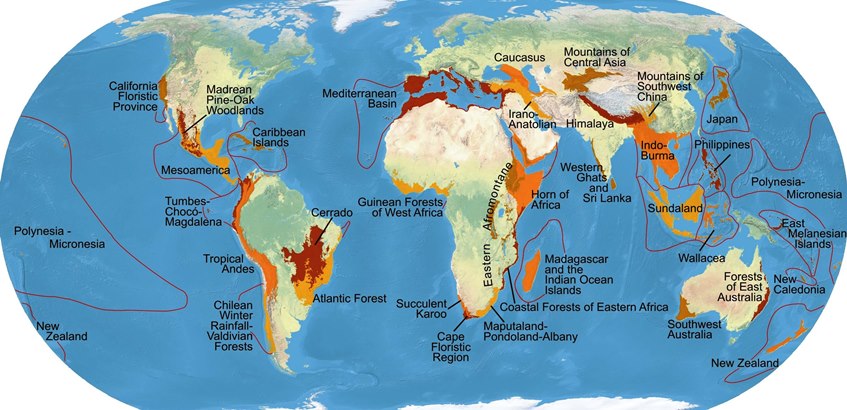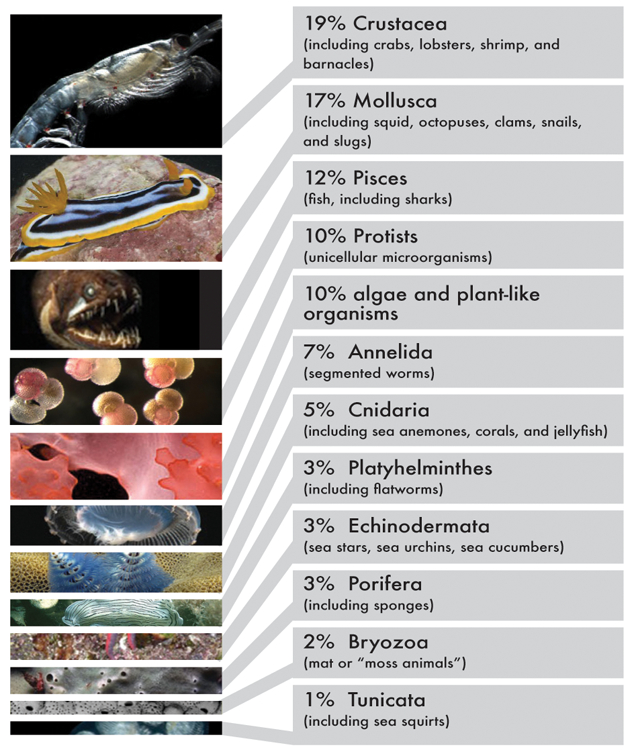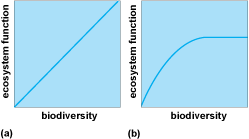Key Concepts
The number of different plant and animal species living in a defined ecosystem or study area; a contraction of biological diversity. Biodiversity includes genetic diversity (variability in the genetic makeup among individuals in a single species), species diversity (the variety of species in different habitats on the Earth), and ecological diversity (the variety of biological communities that interact with one another and with their nonliving environments). Biodiversity can be expressed mathematically as an index that includes both the number of different species in a particular ecosystem (species richness) and the relative abundance of each species present (species equitability). In addition, biodiversity across the world can be affected detrimentally by human activity, especially by human-caused habitat loss and degradation. The biodiversity of these regions, known as biological hotspots (Fig. 1), is a great concern of conservationists. See also: Conservation of species; Ecology; Ecosystem; Species concept

Global biodiversity
Most estimates of the total number of global species range from 3 to 30 million, but some researchers indicate that this number may be greater than 100 million. Out of the total number, though, only about 1.75 million species have been scientifically described. The best-studied groups include plants and vertebrates (phylum Chordata), whereas poorly described groups include fungi, nematodes, and arthropods. Species that live in the ocean (Fig. 2) and in soils remain poorly known. Abiotic factors, such as soil chemistry and prevailing climate, greatly influence biodiversity. The high temperatures and abundant rainfall in tropical rainforests support a far greater biodiversity than do the colder, drier conditions in tundra ecosystems. The vast majority of species is concentrated in the tropical and subtropical regions. See also: Rainforest; Tropics: latitudinal biodiversity gradient

Human activities, such as direct harvesting of species, introduction of alien species, habitat destruction and fragmentation, and various forms of habitat degradation (including environmental pollution), have caused dramatic losses of biodiversity (Fig. 1). The sixth major extinction event in geologic history, termed the Anthropocene extinction, is currently in progress. Indeed, present-day extinction rates are estimated to be 100–1000 times higher than prehuman extinction rates. Many, if not most, plant and animal species alive today remain to be identified, but some are becoming extinct without having been discovered. See also: Anthropocene extinction; Endangered species; Extinction
This rapid loss of species has spurred a great deal of scientific interest in the topic of biodiversity. Currently, many biologists are working to catalog and describe extant species before they are lost. For example, the Great Smoky Mountains National Park in Tennessee and North Carolina comprises more than a half-million acres (more than 200,000 hectares) of wilderness and serves as a refuge for some of the richest and most diverse communities of life in the temperate world. This living wealth led to the park's designation as an International Biosphere Reserve in 1976 and a World Heritage Site in 1983. A large-scale biodiversity survey known as the All Taxa Biodiversity Inventory was launched in 1998 and seeks to locate and identify every species (estimated to be 100,000) living in the park. This ongoing inventory provides a baseline record for the examination of a variety of global factors, including acid rain, climate change, and pollution—knowledge that is essential for the park's biodiversity to be preserved for future generations to enjoy. See also: All Taxa Biodiversity Inventory; Ecological communities
Importance
Ethical and esthetic arguments have been offered regarding the value of biodiversity and why it is necessary to guard against its reduction. Scientists, however, focus on issues such as the biological or ecological functions of biodiversity that can be addressed with experiments rather than debates about values. Certainly, some measure of biodiversity is responsible for providing essential functions and services that directly improve human life. Biodiversity is nature's only blueprint of itself. It is the ultimate gene bank. The rich variety of genes, species, and ecosystems provides humans with food, wood, fibers, energy, raw materials, industrial chemicals, and medicines. The Earth's life forms and ecosystems also provide recycling of nutrients and waste products, generation and maintenance of soils, purification, and natural control of pest species. Every living species contains genetic information that represents thousands to millions of years of adaptation to the Earth's changing environmental conditions and is the raw material for future adaptations. See also: Adaptation (biology)
Ecosystems surely would not function if all species were lost, although it is unclear just how many species are necessary for an ecosystem to function properly. Thus, the current extinction crisis has provoked many scientists to ask how many species can be lost from an ecosystem before the system is negatively affected.
Ecosystem function
Because species are the key working parts of ecosystems, biodiversity must be related to ecosystem function. Studies have assessed this relationship in various ecosystem functions, including biogeochemical processes, the processing of energy, and the flow of nutrients, water, and atmospheric gases. Evidence of the importance of biodiversity for ecosystem function is derived from comparing ecosystems that differ in the number of species present. Ecologists also have undertaken manipulative experiments in which the number of species has been directly varied. In general, these studies have demonstrated that various measures of ecosystem function, such as production of biomass and nutrient uptake, increase as the number of species present increases. However, some studies report no effect or even negative relationships between biodiversity and ecosystem processes.
Although some evidence supports the hypothesis that biodiversity increases or improves the overall functioning of ecosystems, the underlying mechanisms remain unclear. For example, a positive relationship between species diversity and productivity could result because including more species increases the chance of encompassing particularly productive or fast-growing species. Alternatively, a diverse group of species may use the available resources more efficiently because each species has slightly different requirements, resulting in higher overall growth.
It is unclear whether the number of species or the number of different functional types of species is driving these effects. This distinction is important. On the one hand, if the number of species matters most, every species that is added to an ecosystem should cause an improvement in ecosystem function [panel (a) of Fig. 3]. In contrast, if the diversity of functional types is more important than the number of species per se, there will be initial increases in ecosystem function as the number of species rises, but these effects should level off once all of the functional types are represented [panel (b) of Fig. 3]. Indeed, a nonlinear or satiating effect of species number on ecosystem processes is frequently observed [panel (b) of Fig. 3], suggesting that ecosystem function may be relatively unaffected by initial losses of species, but may become severely impaired after some critical number of species is lost.

Ecosystem stability
A second purported benefit of biodiversity is that more diverse ecosystems may be more stable or more predictable through time when compared to species-poor ecosystems. Stability can be defined at the community level as fewer invasions and fewer extinctions. This means that a more stable community will contain a more stable composition of species. However, stability also can be defined at the population level as reduced fluctuations in population size, meaning that a more stable population will contain a more constant number of individuals.
The idea that biodiversity confers stability on ecosystems has a long and controversial history. Early ecologists used several lines of reasoning to argue that diverse ecosystems are more stable than those with fewer species. First, attempts to create simple, low-diversity ecosystems in the laboratory tended to fail, with most or all of the species declining to extinction. Second, unpredictable or strongly cyclical population dynamics are often observed in animals that live at high latitudes, and high-latitude ecosystems generally include relatively few species. Finally, islands, which generally have fewer species than mainlands, tend to be more easily invaded by introduced species. In the mid-1950s, an additional argument was proposed in favor of a positive relationship between biodiversity and ecosystem stability. With more species in an ecosystem, there are more paths through which energy and nutrients can flow; therefore, in diverse ecosystems, each species should be less affected by changes in the abundance of other species, leading to higher overall stability. Thus, the general consensus among early ecologists was that more diverse ecosystems should be more stable. See also: Invasion ecology; Invasive species; Island biogeography; Population ecology
In the early 1970s, mathematical models of many species interacting simultaneously were used to explore the relationship between biodiversity and population stability. The major outcome was that higher species diversity led to less stable population sizes of individual species. However, the apparent conflict between these modeling results and the intuitions of earlier ecologists remained unresolved for many years.
In-depth studies in which the number of species has been manipulated experimentally have helped to resolve this long-standing controversy. For example, manipulations of plant diversity were used to examine not only the productivity of a grassland ecosystem, but also the stability of ecosystem productivity over time. Although this and other studies have shown that the abundance of individual species fluctuates more dramatically in high-diversity ecosystems, the total abundance or productivity of all species combined is actually more stable. High biodiversity decreases the stability of each species' population, lending support to mathematical modeling results, whereas the positive relationship between biodiversity and the stability of overall ecosystem productivity supports the proposals of the earlier ecologists.
Although the relationship between biodiversity and ecosystem stability is fairly clear, the mechanisms generating this pattern are not. In particular, diverse groups of species may be more stable because complementary species compensate for changes in one another's abundance. Alternatively, variation in aggregate measures (such as total productivity) may increase with richness as a result of averaging of random fluctuations in the growth of each species. The strength of this averaging effect depends on correlations among the species' fluctuations, but a positive relationship between biodiversity and the stability of aggregate measures of ecosystem function should usually be expected, due simply to averaging.
In all likelihood, biodiversity is related to both the overall rates and the stability of ecosystem functions. However, documenting a relationship between biodiversity and some measure of ecosystem function or stability does not reveal its underlying cause. Current ecological research continues to explore the mechanisms by which species diversity and functional diversity contribute to ecosystem function. See also: Ecological modeling; Mathematical ecology; Systems ecology
Species importance
Some species clearly play very important roles in ecosystems. In some cases, the addition or deletion of a single species can lead to dramatic changes in ecosystem functions, including productivity or nutrient uptake. For example, the introduction of a nitrogen-fixing tree species to Hawaii resulted in substantially altered productivity and nutrient dynamics in submontane forest ecosystems. Species that exert such strong control over ecosystems are termed keystone species.
It is not at all clear that most species in an ecosystem have such important effects. In other words, it may be possible to lose a number of species from an ecosystem and yet observe little overall impact on ecosystem function. This could be the case if several species that perform approximately the same function are present in the original ecosystem. The situation in which multiple species play a similar role has been termed species redundancy. If species redundancy is a common phenomenon, ecosystem function should be largely independent of species diversity as long as major functional types are represented. Thus, when one species is lost from an ecosystem, some other species with a similar function may become abundant and compensate for the lost species, leaving the ecosystem as a whole relatively unaffected. Indeed, ecosystem processes often do remain stable despite large fluctuations in the abundance of the various species involved. In addition, the relationship between ecosystem function and biodiversity is often observed to be nonlinear [panel (b) of Fig. 3], suggesting that, at least initially, the loss of species would have little overall effect.
The term species redundancy may seem to imply that all species are not necessary for an ecosystem to function properly. However, species redundancy may be an essential feature for the long-term health of ecosystems. Just as engineers include multiple structures with redundant functions to increase overall reliability of the final structure, ecosystems with sets of functionally redundant species may have a built-in safety net that is lacking in species-poor ecosystems. Biodiversity is nature's insurance policy against disasters.
Rare species (those that occur in low abundance) may also appear to contribute relatively little to overall ecosystem functioning. However, during dramatic environmental changes (for example, acidification of a lake), rare species can become very abundant, thereby compensating for reductions in other species. Even species that appear relatively unimportant because they are rare and functionally redundant with others may in fact be important in stabilizing ecosystem function during periods of rare, but intense, stress.
The overwhelming variety of life has captivated the human imagination for centuries, so it is surprising how much scientific uncertainty currently surrounds the role of biodiversity. Ignorance probably reflects the fact that biodiversity has been taken for granted; only over the last few decades, as biodiversity's staggering decline became more apparent, did ecologists start investigating what exactly is being lost. Most experiments provide compelling evidence that at some point the erosion of biodiversity will impair ecosystem function and stability. However, these same experiments also show that a great deal of biodiversity can typically be lost with minimal effects. The value of biodiversity may well be revealed only on huge timescales that incorporate extremely infrequent, but dramatic, environmental challenges. If this is the case, standard short-term experiments will not be able to document the value of many species. Clearly, any failure of short-duration, small-scale experiments to identify a function for total biodiversity or for every species should not be used as a disingenuous argument to excuse human-caused extinctions.





